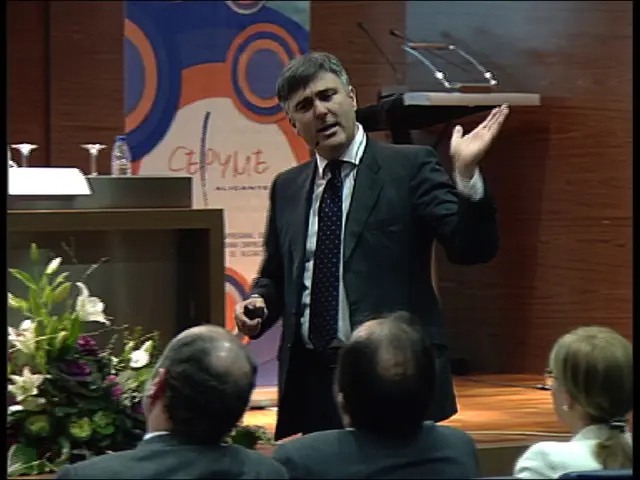Columbus real estate landscape in 2025: escalating property values, considerable developments, and intriguing predictions
Columbus, Ohio, is making significant strides in attracting notable projects and focusing on long-term growth that lifts the entire region. The city is not only a key player in the local real estate market but also a fertile ground for investments.
In the suburbs and exurban cities beyond the city center, such as Whitehall, Reynoldsburg, and Delaware County, the real estate market is buzzing. Delaware County, one of Ohio's fastest-growing counties, has new residential neighborhoods in development, and land and home values have consistently increased.
The office market, however, is likely to face a slow recovery. With the vacancy rate remaining elevated, in the 18-20% range through 2025, it will gradually decline to around 15% by 2028.
The city's commitment to building thousands of affordable units could mean that, even as market-rate rents rise, the lower end of the rental market may see some relief. Columbus' rental sector is expected to remain favorable for landlords in the coming years, with a low vacancy rate (likely around 5% or less).
Columbus leaders have been examining tenant protection ordinances, such as requiring longer rent increase notices or providing legal assistance to tenants facing eviction. The city of Columbus is updating its zoning codes to encourage housing development and simplify approvals, legalizing higher-density housing in more areas and speeding up the overall approval process for developments.
The industrial boom will continue, though perhaps not at the same accelerated pace as at the beginning of the 2020s. Honda and LG Energy's joint venture are constructing battery factories near Columbus, solidifying the auto sector in central Ohio. Intel's planned semiconductor factories, valued at $20 billion, in Licking County (just outside Columbus) are expected to directly employ 3,000 people (and many more in supporting industries) once fully operational.
Columbus offers a relatively affordable alternative compared to coastal cities, with lower taxes, cheaper real estate, and a central location. The city's effort to build more housing could open regulations for accessory dwelling units (ADUs), small multifamily projects, and in-law suites in areas that previously didn't allow them.
Sales activity is expected to increase in 2025 and beyond, with a ~9% increase in U.S. home sales in 2025. The 2020 expansion of Ohio State University's west campus into an "Innovation District" brings new labs, offices, and student housing, further integrating with the city.
Cities like Johnstown, Newark, Heath, and Pataskala in Licking County are experiencing housing demand due to corporate expansions. Peninsula Scioto and other mixed-use developments (Peninsula phase, North Market Tower, etc.) will add hundreds of housing units and new attractions by 2026, potentially boosting downtown living appeal and, potentially, increasing demand for condominium apartments.
Columbus' presence of Ohio State University, one of the nation's largest universities, is a constant economic engine, generating research, healthcare, and startups that fuel the real estate market. Columbus frequently scores well in rankings like "best places for young professionals" and "best cities for tech jobs".
The city's effort to eliminate regulatory barriers to allow the private sector to build more housing, especially "missing middle" housing (2-4 unit buildings, small condominiums) that can be more affordable than large single-family homes or luxury high-rises, is commendable.
Columbus is also making strides in public transportation. LinkUS transit lines could see the first BRT route under construction by 2025-26 if funding aligns, potentially stimulating development oriented along those corridors.
Columbus was ranked first in the 2025 Global Groundwork Index by Site Selection Magazine for efficiently aligning infrastructure investments with business growth. The robust creation of jobs is a cornerstone of Columbus's strong real estate market, with an unemployment rate around 4%.
Building on this basis, Mayor Ginther has proposed a new $500 million bond issue for housing for the 2024 ballot, which, if approved, would significantly accelerate efforts to add affordable housing in the next decade. The city of Columbus is aggressively pursuing federal funding for projects, with recent grants financing airport expansion, modernization at Rickenbacker Inland Port, and improvements to highways like the I-70/I-71 interchange.
Despite higher interest rates making maintenance costs more expensive for flippers and renovators, a typical single-family home in a working-class neighborhood in Columbus might still achieve a capitalization rate of ~7-8%, which is attractive, but competition for such properties has increased. Historically, Columbus investors have enjoyed reliable cash flows - relatively high capitalization rates - although as prices rise, yields have compressed somewhat.
Columbus is "cool" in a way it probably wasn't 20 years ago, and this perception stimulates housing demand from new arrivals seeking an urban, yet accessible, lifestyle. Columbus is expected to see more infill development, creative reuse of vacant land, and potentially higher-density projects near public transportation lines in the coming years.
As Columbus continues to grow, cities like London and West Jefferson (Madison County) could evolve into commuter suburbs for Columbus in the next decade, representing long-term investments. Columbus's real estate market is expected to continue its growth trajectory through the end of the decade, at a moderate pace.




